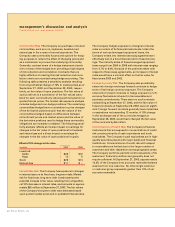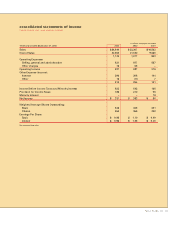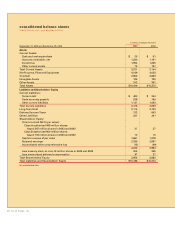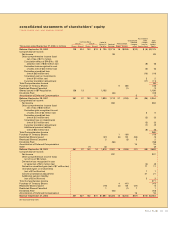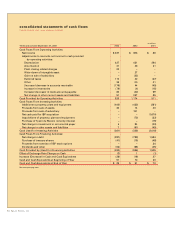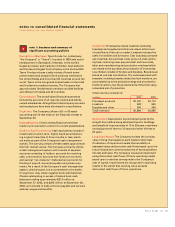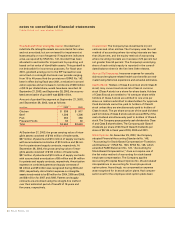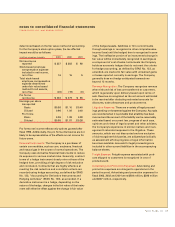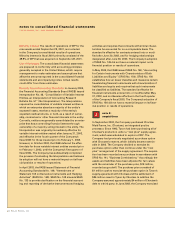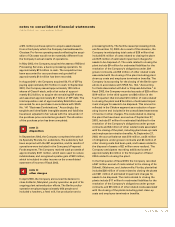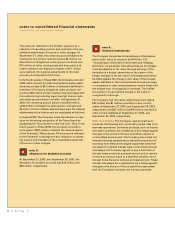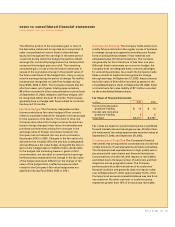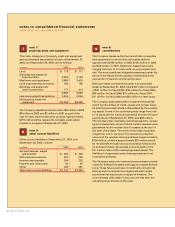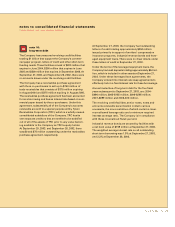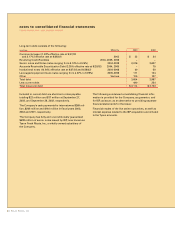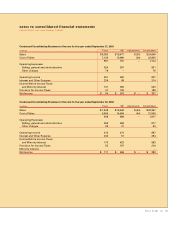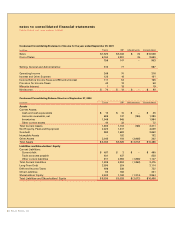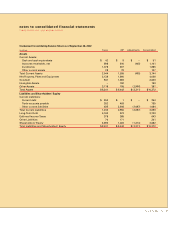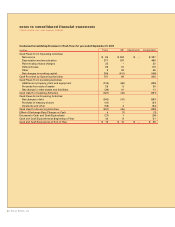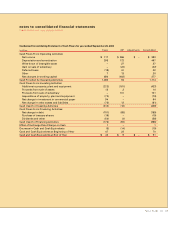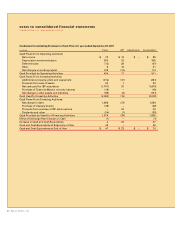Tyson Foods 2003 Annual Report Download - page 42
Download and view the complete annual report
Please find page 42 of the 2003 Tyson Foods annual report below. You can navigate through the pages in the report by either clicking on the pages listed below, or by using the keyword search tool below to find specific information within the annual report.
40 Tyson Foods, Inc.
notes to consolidated financial statements
TYSON FOODS, INC. 2003 ANNUAL REPORT
The costs are reflected in the Chicken segment as a
reduction of operating income and included in the con-
solidated statements of income in other charges. At
September 27, 2003, the remaining accrual balance for
closing the two poultry operations was $2 million, as
$16 million of obligations under grower contracts and
$12 million of other closing costs had been paid, and
losses related to the disposal of assets of $17 million
were realized. No material adjustments to the total
accrual are anticipated at this time.
In the fourth quarter of fiscal 2002, the Company recorded
a $26 million accrual for restructuring its live swine opera-
tions that consists of $21 million of estimated liabilities for
resolution of Company obligations under producer con-
tracts and $5 million of other related costs associated with
this restructuring including lagoon and pit closure costs
and employee termination benefits. At September 27,
2003, the remaining accrual balance was $16 million,
as $6 million of obligations under grower contracts and
$4 million of other related costs had been paid. No material
adjustments to the total accrual are anticipated at this time.
In August 2002, the Company made the decision to capi-
talize on the strong recognition of the Tyson brand by
expanding the Tyson brand to beef and pork. Thus, in the
fourth quarter of fiscal 2002 the Company recorded a
write-down of $27 million related to the discontinuation
of the Thomas E. Wilson brand. This amount is reflected
in the Prepared Foods segment as a reduction to operat-
ing income and included on the consolidated statement
of income in other charges.
note 5:
allowance for doubtful accounts
At September 27, 2003, and September 28, 2002, the
allowance for doubtful accounts was $16 million and
$26 million, respectively.
5
note 6:
financial instruments
The Company recognizes all derivatives on the balance
sheet at fair value as required by SFAS No. 133,
“Accounting for Derivative Instruments and Hedging
Activities,” as amended. Derivatives that are not hedges
must be adjusted to fair value through earnings. If the
derivative is a hedge, depending on the nature of the
hedge, changes in the fair value of derivatives will either
be offset against the change in fair value of the hedged
assets, liabilities or firm commitments through earnings,
or recognized in other comprehensive income (loss) until
the hedged item is recognized in earnings. The ineffec-
tive portion of a derivative’s change in fair value is
recognized in earnings.
The Company had derivative related balances totaling
$20 million and $1 million recorded in other current
assets at September 27, 2003, and September 28, 2002,
respectively, and $37 million and $19 million recorded in
other current liabilities at September 27, 2003, and
September 28, 2002, respectively.
Cash Flow Hedges: The Company uses derivatives to
moderate the financial and commodity market risks of its
business operations. Derivative products, such as futures
and option contracts, are considered to be a hedge against
changes in the amount of future cash flows related to
commodities procurement. The Company also enters into
interest rate swap agreements to adjust the proportion of
total long-term debt and leveraged equipment loans that
are subject to variable interest rates. Under these interest
rate swaps, the Company agrees to pay a fixed rate of
interest times a notional principal amount and to receive
in return an amount equal to a specified variable rate of
interest times the same notional principal amount. These
interest rate swaps are considered to be a hedge against
changes in the amount of future cash flows associated
with the Company’s variable rate interest payments.
6


